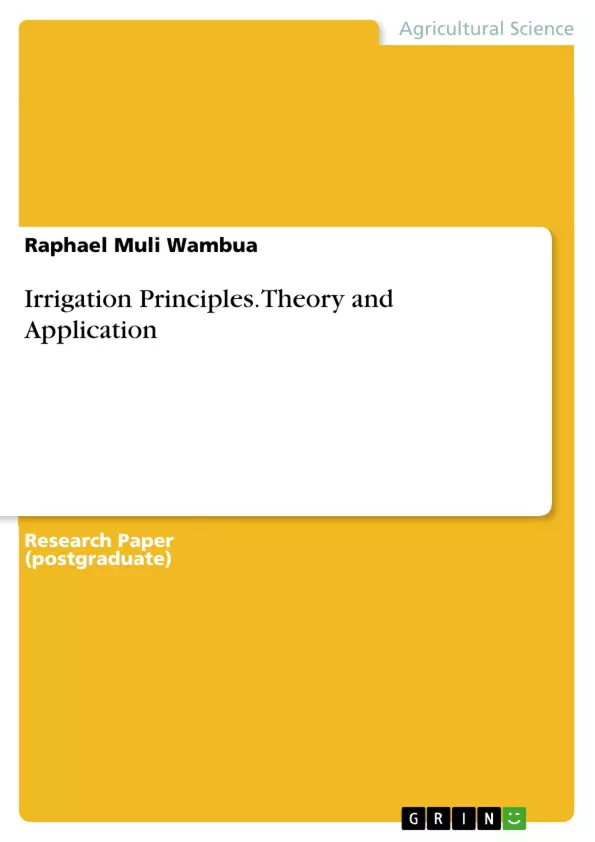Irrigation Principles (Theory and Application) is a text book intended for students and instructors in University or higher education for Certificate, Diploma and Degree students in a number of courses such as Irrigation and Drainage, Agricultural Engineering, General Agriculture, Agricultural Education and Extension, Horticulture, Water Resources Engineering, applied irrigation engineering and other allied professions.
The content of the text book has been presented in a lucid style, arranged in coherent sequence that adheres to University and higher education curriculum. This makes the book suitable for relaxed reading. For the calculations, worked examples have been solved in a way of illustration and details are presented. Each chapter is concluded with the examples and review questions for the readers to expound on subject knowledge. For the purpose of improvement, any criticism from students, trainers and practitioners will be thankfully received by the author.
Table of Contents
- Introduction
- Definition and Scope of Irrigation
- What is Irrigation?
- Scope of Irrigation
- Irrigation Requirements
- Water Requirements of Crops
- Factors Affecting Water Requirements of Crops
- Irrigation Systems
- Surface Irrigation Systems
- Sprinkler Irrigation Systems
- Drip Irrigation Systems
- Sub-surface Irrigation Systems
- Irrigation Scheduling and Management
- Water Balance and Irrigation Scheduling
- Irrigation Management Strategies
- Irrigation Efficiency
- Measurement of Irrigation Efficiency
- Factors Affecting Irrigation Efficiency
- Irrigation and Environmental Impacts
- Water Quality Impacts
- Soil Salinity and Waterlogging
- Sustainable Irrigation Practices
- Water Conservation Techniques
- Efficient Irrigation System Design
Objectives and Key Themes
This book aims to provide a comprehensive understanding of irrigation principles and their practical applications in modern agriculture. It serves as a valuable resource for students, instructors, and professionals involved in irrigation, agriculture, and water resources management. The text delves into the theoretical foundations of irrigation, examines different irrigation systems, and explores techniques for efficient irrigation scheduling and management.
- Understanding the definition, scope, and importance of irrigation in modern agriculture
- Exploring the water requirements of crops and the factors influencing them
- Evaluating various irrigation systems, their advantages, and disadvantages
- Developing strategies for efficient irrigation scheduling and management to optimize water use
- Analyzing the environmental impacts of irrigation and promoting sustainable irrigation practices
Chapter Summaries
The book begins by defining irrigation and outlining its scope in modern agriculture. It then examines the water requirements of crops and the factors influencing them, including climate, soil type, and crop stage. The book explores different irrigation systems, covering surface irrigation, sprinkler irrigation, drip irrigation, and sub-surface irrigation. Each system is discussed in detail, highlighting its advantages, disadvantages, and applicability in different contexts.
The book further delves into irrigation scheduling and management, emphasizing the importance of water balance and efficient irrigation practices. It discusses strategies for optimizing water use, minimizing water losses, and maximizing crop yields. The text also examines the environmental impacts of irrigation, focusing on water quality, soil salinity, and waterlogging. Finally, the book explores sustainable irrigation practices, promoting water conservation techniques and efficient irrigation system design.
Keywords
The book focuses on key terms and concepts related to irrigation principles and applications, including water requirements, irrigation systems, irrigation scheduling, irrigation efficiency, environmental impacts, and sustainable irrigation practices. It delves into specific topics such as surface irrigation, sprinkler irrigation, drip irrigation, sub-surface irrigation, water balance, irrigation management strategies, water conservation, and efficient irrigation system design.
- Citar trabajo
- Raphael Muli Wambua (Autor), 2019, Irrigation Principles. Theory and Application, Múnich, GRIN Verlag, https://www.grin.com/document/458531



